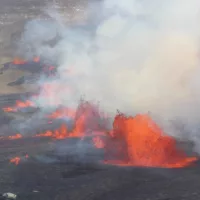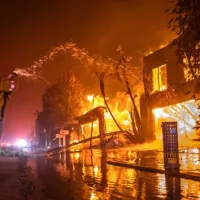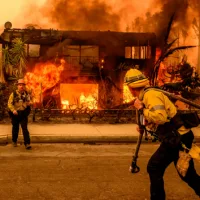
(HILO, Hawaii) — Hawaii’s Kilauea volcano, one of the most active in the world, is erupting again, prompting a volcano watch alert in surrounding areas, according to officials.
The eruption is occurring within a remote area of Hawaii Volcanoes National Park, according to the U.S. Geological Survey’s (USGS) Hawaiian Volcano Observatory.
Lava began flowing from a new fissure vent that opened from east to west within the volcano’s Nāpau Crater early Tuesday morning, the USGS said.
Several lava fountains about 32 feet high and pools of lava on the floor of the crater were observed by helicopters flying over the eruption Tuesday morning.
A separate fissure west of the Nāpau Crater began emitting lava on Monday, stopping after a few hours and then resuming activity later that evening, according to the USGS, which also noted that the eruption was preceded by a sequence of below-ground earthquakes.
About 17 earthquakes were detected beneath the Kilauea summit region between Monday and Tuesday. The earthquakes occurred at depths between .6 and 1.9 miles below the ground surface, the USGS said.
The USGS issued a volcano watch – known as a code orange – which means that an eruption is either likely or occurring but with no, or minor, ash.
There is no immediate threat to life or infrastructure, but residents nearby may experience volcanic gas emissions related to the eruption, the USGS said.
Yet hazards remain around the Kilauea caldera from the instability of the Halemaʻumaʻu crater wall, the USGS said. Ground cracking and rockfalls can be enhanced by earthquakes.
Volcanic smog, known as vog, presents airborne health hazards to people and livestock and has the potential to damage agricultural crops and other plants, according to the USGS.
The USGS further warned that additional ground cracking and outbreaks of lava around the active and inactive fissures in Kilauea are also possible.
Another potential hazard is Pele’s hair, a volcanic glass formation produced from cooled lava that’s stretched into thin strands. The USGS warns that winds could carry lighter particles from the strands downwind. Contact with the particles can cause skin and eye irritation, according to the USGS.
Eruptions at Kilauea have been destructive in the past. In 2018, more than 600 properties were destroyed by heavy lava flow that stretched from the Kilauea summit to the ocean.
Unusual eruptions that were described as being similar to a “stomp-rocket toy,” a children’s toy that involves launching a rocket into the air after stomping on the release mechanism, contributed to the severity of the lava flow and could potentially impact future eruptions, according to a paper published earlier this year in Nature Geosciences.
The area surrounding the rim of Kilauea’s Halemaʻumaʻu crater has been closed to the public since 2008 due to the hazards.
ABC News’ Bonnie Mclean contributed to this report.
Copyright © 2024, ABC Audio. All rights reserved.















